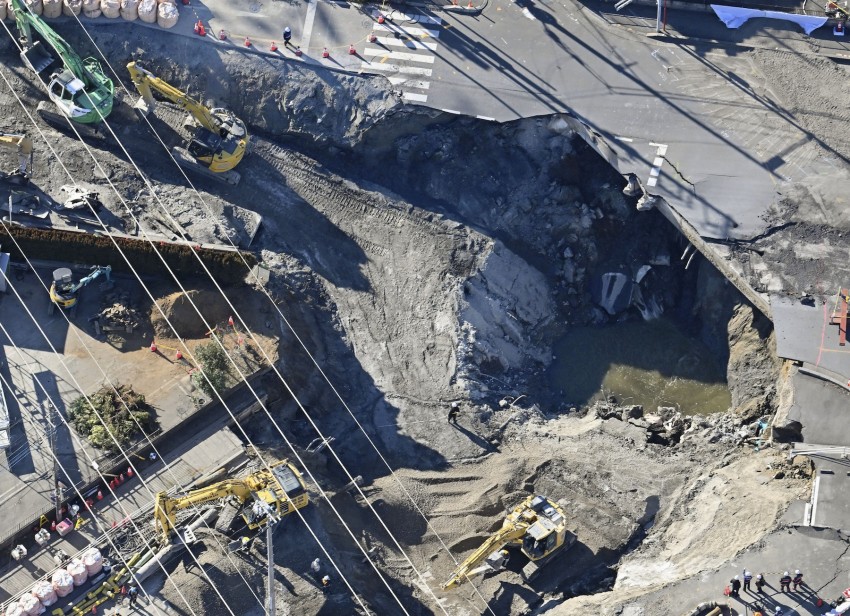The missing cabin of a truck swallowed by a huge sinkhole that emerged at an intersection in Yashio, Saitama Prefecture, was located in a sewer pipe nearby, local officials said Tuesday.
A search of the sewer pipe near the site using a drone found the truck cabin about 30 meters downstream of the sinkhole, prefectural officials said.
Images taken by the drone suggest there is a human body inside the truck cabin, but rescuers cannot enter the pipe due to continuous water flow and high levels of hydrogen sulfide gas in the nearly 5-meter-diameter pipe, officials said.
Saitama Gov Motohiro Ono told reporters that rescuers will attempt to remove the truck cabin after installing a temporary bypass pipe, but the process could take about three months.
The sinkhole, which emerged on Jan 28, swallowed the truck of a 74-year-old driver and eventually expanded to about 40 meters wide and 15 meters deep.
Rescuers built a ramp into the sinkhole to clear mud and rubble with heavy machinery, but the search inside was called off.
© KYODO















19 Comments
Login to comment
quercetum
Take your sweet old time.
WoodyLee
The first 2 hours were the most critical and precious moments to save the driver life and were missed because there were NO HEROS around and lack of preparations for such events.
All What was needed is a cable / cables hocked to the truck to lock it in place and prevent it from sinking further at first, then rescuers could have been safely lowered by a Helicopter or a large crane from a Safe Distance to free the man from the cabin.
DanteKH
This is very sad news indeed. I cannot imagine what is in his family's hearts knowing that his body is still there and cannot be retrieved for a very long time due to conditions.
Alongfortheride
Can you do it any faster? If yes give them a call.
Alongfortheride
The cab of the truck was completely covered so hooking a cable on the the frame at the rear would have been pointless as the forces will have ripped the cab of the chassis , which it did anyway. I am quite confident the emergency services did everything they could have to save this guy without the further loss of life.
kwatt
I thought this sinkhole is a little accident but the biggest disaster now.
Yubaru
Wow, talk about "instant" gratification syndrome!
stormcrow
That poor guy. Talk about being in the wrong place at the wrong time.
wallace
It would not have happened if they had not separated the truck from its cab.
Asiaman7
@Alongfortheride
No, the cab was not completely covered until several hours after the initial accident.
As @WoodyLee stresses above, “The first 2 hours were the most critical and precious moments to save the driver’s life.”
Excerpt below from the New York Times report.
—
The driver was alive immediately after the truck sank into the hole, responding to nearby rescuers, according to the public broadcaster NHK. However, a few hours later, a mudslide inside the hole caused dirt and rubble to fall onto the vehicle, burying it. The man has not responded to subsequent attempts to make contact.
quercetum
Unfortunately just not fast enough. Have to in an emergency mode instead of politely shouting down into the sinkhole,”daijobu desu ka?”
Zaphod
That means they located the driver. What a horrible way to go for the poor guy.
Zaphod
WoodyLee
How exactly do you "prepare" for this particular event? The fire department was on the scene very quickly, but exactly what "preparation" do you have in mind for them?
Zaphod
You do realize that the walls of the hole collapsed and buried the cabin? And that when they pulled the truck out with cables as you brilliantly suggest, the cabin separated from the truck? There is no "all that was needed" here, good grief.
Asiaman7
Active training scenarios could include quickly (1) Cutting power to a block, (2) Cutting obstructing power lines, (3) Lowering a rescue winchman by helicopter.
Firefighters and coast guard personnel periodically conduct rescue drills and scenarios. These could easily be added.
Asiaman7
We’re talking about a rescue in those hours before the hole collapsed — before dirt and rubble covered the vehicle and driver.
USNinJapan2
I'm sure no one foresaw the cab shearing off of the chassis when they initially tried to drag the truck out of the hole. In retrospect, the only thing that may have worked to prevent this was to use a powerful enough industrial electromagnet on a crane, but I don't think the first responders can be blamed for not considering it as an option.
Asiaman7
As a commenter mentioned the other day, if the victim was a person of prominence, the authorities would likely have gotten him out of there by rapidly moving earth and heaven.
Zaphod
Asiaman7
I do not believe that for a second, looking at the physical situation. Sure, there would have been a lot more media interest, but "the authorities" can not do miracles either.
Bret T
When younger, I was involved with emergency response for 10 years. After every significant event there was a thorough review, critique, and plan for improvement when opportunities were found. No egos or blame game, just here is the situation, actions taken, and the end results. What could we have done better?
I'm sure Japanese first responders do the same. A good follow-up article would be coverage of this activity and the path forward. This man's life is gone, but maybe lessons learned can help save someone in the future.
rainyday
“Armchair emergency responder”.
Noun. One who second guesses the actions of emergency responders making difficult decisions in a dangerous and high stress situation from the comfort of an armchair with the benefit of hindsight and without having actually been there.
See also armchair general.